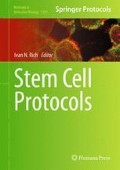Abstract
Recent attention on the early development of circadian rhythms has yielded several avenues of potential study regarding molecular and physiological rhythms in embryonic stem cells (ESCs) and their derivatives. While general guidelines of experimental design are—as always—applicable, there are certain idiosyncrasies with respect to experiments involving circadian rhythms that will be addressed. ESCs provide a number of challenges to the circadian biologist: growth rates are normally much higher than in established cell culture systems, the cells’ innate drive towards differentiation and the lack of known synchronizing input pathways are a few examples. Some of these challenges can be addressed post hoc, such as normalization to total RNA or protein for transcript abundance studies. Most others, as outlined here, require special handling of the samples before and during experimentation in order to preserve any potential circadian oscillation that is present. Failure to do so may result in a disruption of endogenous oscillation(s) or, potentially worse, generation of an artificial oscillation that has no biological basis. This chapter begins with cultured ESCs, derived from primary blastocysts or in the form of cell lines, and outlines two methods of measuring circadian rhythms: the 2DG method of measuring glucose uptake (Sokoloff et al. J Neurochem 28:897–916, 1977) and real-time measurement of molecular rhythms using transgenic bioluminescence (Yoo et al. Proc Natl Acad Sci U S A 101:5339–5346, 2004).
Access this chapter
Tax calculation will be finalised at checkout
Purchases are for personal use only
References
Pittendrigh CS (1993) Temporal organization: reflections of a Darwinian clock-watcher. Annu Rev Physiol 55:16–54
Bell-Pedersen D, Cassone VM, Earnest DJ et al (2005) Circadian rhythms from multiple oscillators: lessons from diverse organisms. Nat Rev Genet 6:544–556
Pittendrigh CS (1960) Circadian rhythms and the circadian organization of living systems. Cold Spring Harb Symp Quant Biol 25:159–184
Pittendrigh CS (1981) Circadian systems: entrainment. In: Aschoff J (ed) Biol. Rhythm. Springer, Boston, pp 95–124
Pittendrigh CS (1954) On temperature independence in the clock system controlling emergence time in Drosophila. Proc Natl Acad Sci U S A 40:1018–1029
Buhr ED, Takahashi JS (2013) Molecular components of the Mammalian circadian clock. Handb Exp Pharmacol (217):3–27. doi:10.1007/978-3-642-25950-0_1
Paulose JK, Rucker EB, Cassone VM (2012) Toward the beginning of time: circadian rhythms in metabolism precede rhythms in clock gene expression in mouse embryonic stem cells. PLoS One 7:e49555. doi:10.1371/journal.pone.0049555
Guido ME, Garbarino-Pico E, Contin MA et al (2004) Circadian regulation of phospholipid biosynthesis in chick retinal ganglion cells. ARVO Meet Abstr 45:3666
Sládek M, Sumová A (2013) Entrainment of spontaneously hypertensive rat fibroblasts by temperature cycles. PLoS One 8:e77010. doi:10.1371/journal.pone.0077010
Schwartz WJ, Gainer H (1977) Suprachiasmatic nucleus: use of 14C-labeled deoxyglucose uptake as a functional marker. Science 197:1089–1091
Sokoloff L, Reivich M, Kennedy C et al (1977) The [14C]deoxyglucose method for the measurement of local cerebral glucose utilization: theory, procedure, and normal values in the conscious and anesthetized albino rat. J Neurochem 28:897–916
Earnest DJ, Liang FQ, Ratcliff M et al (1999) Immortal time: circadian clock properties of rat suprachiasmatic cell lines. Science 283:693–695
Paulose JK, Peters JL, Karaganis SP et al (2009) Pineal melatonin acts as a circadian zeitgeber and growth factor in chick astrocytes. J Pineal Res 46:286–294
Hastings JW, Sweeney BM (1958) A persistent diurnal rhythm of luminescence in Gonyaulax polyedra. Biol Bull 115:440–458
Yamazaki S, Numano R, Abe M et al (2000) Resetting central and peripheral circadian oscillators in transgenic rats. Science 288:682–685
Yoo S-HH, Yamazaki S, Lowrey PL et al (2004) PERIOD2::LUCIFERASE real-time reporting of circadian dynamics reveals persistent circadian oscillations in mouse peripheral tissues. Proc Natl Acad Sci U S A 101:5339–5346
Yagita K, Horie K, Koinuma S et al (2010) Development of the circadian oscillator during differentiation of mouse embryonic stem cells in vitro. Proc Natl Acad Sci U S A 107:3846–3851
Kowalska E, Moriggi E, Bauer C et al (2010) The circadian clock starts ticking at a developmentally early stage. J Biol Rhythms 25:442–449
Author information
Authors and Affiliations
Corresponding author
Editor information
Editors and Affiliations
Rights and permissions
Copyright information
© 2015 Springer Science+Business Media New York
About this protocol
Cite this protocol
Paulose, J.K., Rucker, E.B., Cassone, V.M. (2015). Analysis of Circadian Rhythms in Embryonic Stem Cells. In: Rich, I. (eds) Stem Cell Protocols. Methods in Molecular Biology, vol 1235. Humana Press, New York, NY. https://doi.org/10.1007/978-1-4939-1785-3_7
Download citation
DOI: https://doi.org/10.1007/978-1-4939-1785-3_7
Published:
Publisher Name: Humana Press, New York, NY
Print ISBN: 978-1-4939-1784-6
Online ISBN: 978-1-4939-1785-3
eBook Packages: Springer Protocols

